The 2013 MacBook Air Review (13-inch)
by Anand Lal Shimpi on June 24, 2013 12:01 AM ESTAbsolutely Insane Battery Life
With Haswell ULT, Intel aggressively focused on driving down total platform power consumption. It turns out that although Intel did a wonderful job of driving down CPU power consumption over the years, it did nothing to make the rest of the platform keep up. With Haswell ULT, all of that changed. Intel is being frustratingly cagey with giving up real details on exactly what’s going on with Haswell ULT, but here’s what I’ve been able to piece together.
For starters, Haswell ULT brings the PCH (Platform Controller Hub) on-package. The PCH is responsible for all SATA, USB, PCIe 2.0 and other rest-of-system interfaces. Bringing it on package reduces the amount of power needed to drive traffic between the CPU and PCH, which in turn helps reduce platform power.
The PCH also moves down to 32nm, helping further reduce power consumption. Haswell ULT silicon itself is binned for lower voltage/power operation. The combination of Haswell ULT CPU and PCH are both included in the new 15W TDP (there’s a 28W version as well but not used in the MacBook Air).
Haswell ULT supports lower power sleep states (up to C10) than the standard mobile or desktop parts (C6/C7).
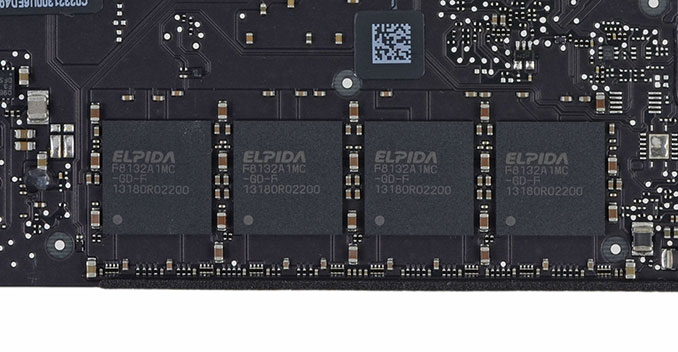
Image Courtesy iFixit
The other big change, and one that Apple is among the first (only?) to take advantage of is Haswell ULT’s support for LPDDR3. Standard DDR3 operates at 1.5V, while low-voltage DDR3L drops that down to 1.35V - the two standards are otherwise identical. LPDDR3 on the other hand drops voltage even further (1.2V) while introducing architectural features to drive power down even lower. LPDDR3‘s power advantage is why it’s frequently used in smartphones vs. DDR3L. The biggest downside is cost. Apple has historically not had an issue with spending a bit extra to get a better overall experience, so it’s not surprising to see the MacBook Air ship with LPDDR3.
Overall bandwidth remains unchanged despite the move to very low power memory. We’re still dealing with a 128-bit wide memory interface with a 1600MHz datarate. Note the impact this has on DRAM device layout on the PCB itself. Last year's model required 16 DDR3L devices, compared to 4 x 32-bit LPDDR3 devices here. Anyone else smell laptop/tablet convergence coming this way?
Haswell ULT also enables support for Intel’s Power Optimizer framework. I’ve talked about this extensively over the past several months, but it’s effectively a messaging system that allows all devices/controllers within a system to coordinate going into sleep states during periods of idle time. Of all of the platform power optimizations, this is the only one that isn’t currently taken advantage of in OS X. You’ll have to wait for OS X Mavericks to realize these gains.
Apple also boosted overall battery capacity on the MacBook Airs by roughly 8%. The increase in battery capacity had no impact on weight. Although it’s not immediately apparent, I would assume that Apple’s new SSDs also support DevSleep (DEVSLP) and Runtime D3.
The result of all of this is a downright tremendous improvement in battery life. OS X already did very well in the idle power department. Haswell’s FIVR (Fully Integrated Voltage Regulator) can more quickly/aggressively enter and exit low power states. The combination of which is really the perfect storm for increasing battery life.
On the 13-inch MBA, Apple claims up to 12 hours of usage on a single charge.
Apple even revised its own testing in order to make its quoted battery life numbers more realistic. Previously it ran all of its own battery life tests at 50% brightness, but starting with the MacBook Air Apple’s quoted battery life numbers are at 75% brightness. Our tests by comparison are at 81.5% (200 nits on the MBA). Apple’s changes to its battery testing methodology actually tend to unintentionally mirror ours. Our first Mac battery life tests ran at roughly 50% brightness (100 nits).
So how did the MacBook Air fare in our testing? To find out I turned to our updated 2012 battery life test suite, first introduced with the 15-inch rMBP review.
The light and medium suites are inherently related - they use the same workload and simply vary the aggressiveness of that workload. The light test hits four different websites every minute, pausing for nearly the entire time to simulate reading time. Flash is enabled and present on three of the sites. The long pause time between page loads is what really makes this a light test. Web browsing may be the medium for the test but if all you’re doing is typing, watching Twitter update and maybe lazily doing some other content consumption this is a good representation of the battery life you’ll see. It’s a great way of estimating battery life if you’re going to be using your notebook as a glorified typewriter (likely a conservative estimate for that usage model).
The medium test hits the same webpages (Flash and all) but far more aggressively. Here there’s less than 10 seconds of reading time before going onto the next page. It sounds like a small change but the impact on battery life is tremendous.
Both the light and medium tests are run in their default state with processor graphics enabled, as well as with the discrete GPU forced on. I run with the dGPU on as well because it’s far too often that a single application open in the background will fire up the dGPU and contribute to draining your battery. The goal here is to deliver useful numbers after all.
The final test is very similar to our old heavy multitasking battery life tests, but with some updates. Here I’m downloading large files at a constant 1MB/s from a dedicated server, while playing back a looped 1080p H.264 movie (the Skyfall trailer) all while running the medium battery life test. The end result is a workload that gives you a good idea of what a heavy multitasking usage model will do in terms of battery life. I’ve found that OS X tends to fire up the dGPU anyway while running this workload so I saw no reason to run a separate set of numbers for processor and discrete graphics.
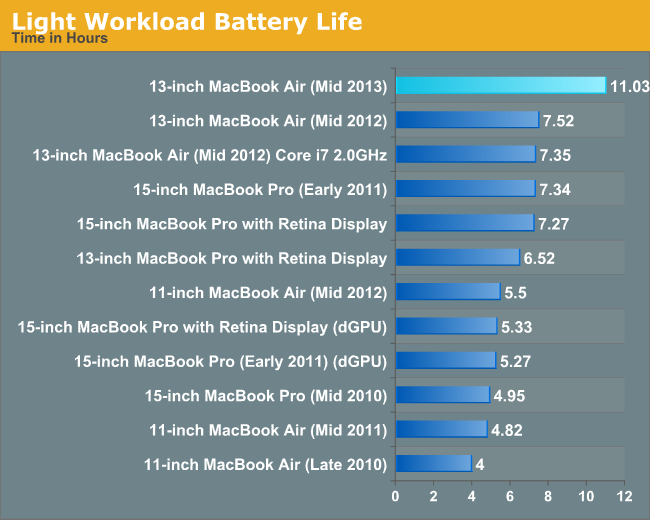
This is just ridiculous. Apple claims 12 hours, we tend to test a little more strenuous than Apple does and ended up with just over 11 hours of battery life on a single charge. These highly idle cases end up dominated by display power, which is why we actually see the smallest improvement in battery life over the previous generation here (~35%, normalized for battery capacity). If you drop brightness down to something more reasonable (~100 nits) you’ll get some truly insane numbers:
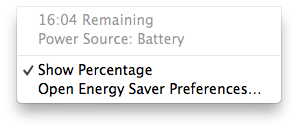
I remember owning a Transmeta Crusoe based Sony Picturebook (C1VN) with an extended battery and being able to break 14 hours of battery life. I had to give up so much performance and usability to get that sort of battery life back then; with the new MacBook Air, I don’t have to.
Now this is really the sort of battery life you can expect when using the 13-inch MBA as a glorified typewriter. What happens if you start using the system a bit more aggressively?
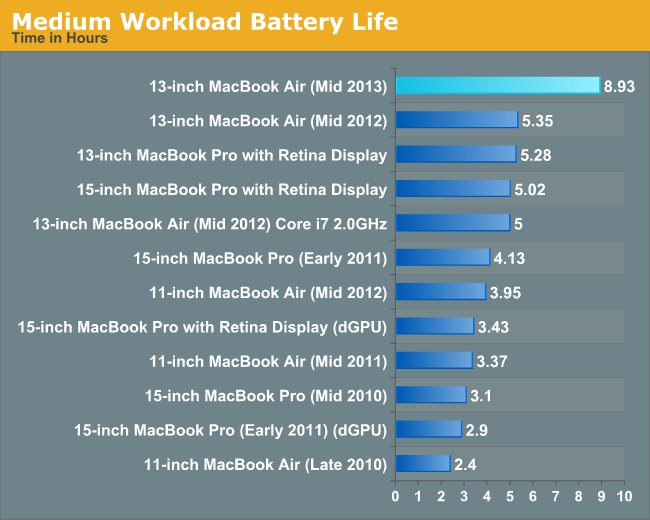
Just under 9 hours on a single charge, an increase of 54.5% when you normalize for battery capacity. What the world would’ve done if Haswell ULT hit prior to the creation of the iPad...
The reason I create/present three different battery life tests is to showcase a range of expected battery life. No one number is going to characterize what you can expect out of the system, but my hope is you’ll get a good idea of range by looking at the numbers here. The heavy test used to provide a good look at worst case scenario, but I’m beginning to wonder if I need something even more stressful:
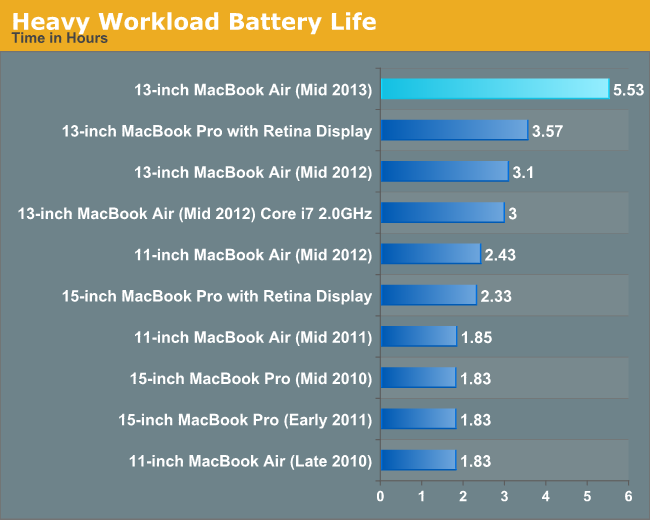
Even normalizing for battery capacity changes, the new 13-inch MacBook Air increases battery life by 65% over the previous model.
Under really heavy use (think tons of video/photo editing work) you can go even lower than what our heavy workload numbers show. In my experience I found that around 7 hours of battery life on a single charge is reasonable for most of my workloads, but when doing a lot of work (tons of Flash tabs open, compiling a project in the background and heavy multitasking) I could kill the 13-inch MBA in under 4 hours.
The benefit of the new MBA is really in its ability to extend its battery life when needed. Close Safari windows, turn down the brightness, and you’ve got a machine that can last for a very long time without needing a wall outlet. There's a good reason that OS X Mavericks focuses so much on putting background tasks/apps to sleep, maximizing idle time is really the key to getting this insane amount of battery life.


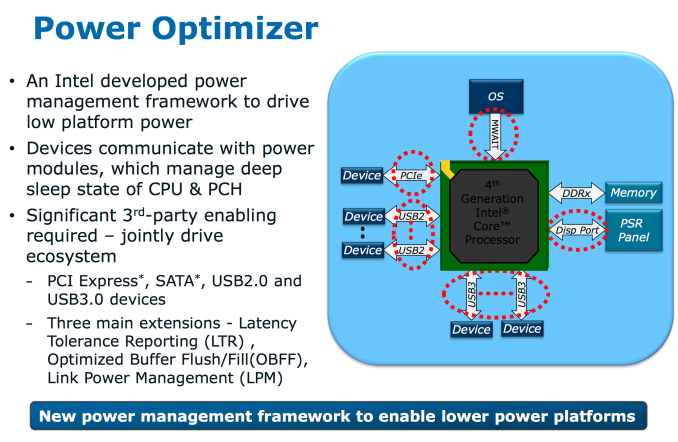








233 Comments
View All Comments
darwinosx - Monday, June 24, 2013 - link
Another peson who didn't read the article and knows nothing about Macs.watersb - Monday, June 24, 2013 - link
Excellent review!If only it were available with RAM...
darwinosx - Monday, June 24, 2013 - link
If only you took tow seconds to find out you can order it with 8 GB of ram.appliance5000 - Friday, December 20, 2013 - link
It's available with 8gb ram - but here's the rub: If you have the 512gb ssd coupled with the fact that it's mounted on the pcie bus, your page ins and outs are about as fast as memory - or seemingly so. It's a very fast machine - I've tested it stitching multi gb panos and editing multi gb layered files in CS6 and it just rips.FrozenDarkness - Monday, June 24, 2013 - link
I think people get retina confused with higher resolution computers. Couple things, your windows computer? DPI up scaling sucks too much to truly run retina. Know that retina on a 13 MBP actually runs at a resolution of 1280x800 to be truly "retina" or else you're just up-scaling then down-scaling and burning your graphics card in the process. So in a sense, it's not truly higher resolution in terms of workspace, just in terms of beauty to behold. This also means a MBA retina would have to be a different, higher resolution panel, than the one used in the 13" MBP and at that point, what is the point of the MBP? I think you're more likely to see the MBP become more lik the MBA in size than vice versa.Also, panel lottery sucks, let's not act like apple is the only manufacturer who has a panel lottery or that samsung are only in "review" units.
A5 - Monday, June 24, 2013 - link
Windows 8.1 is supposed to fix the DPI scaling in Windows. Win8 is already significantly better than 7.Beyond that, sharper pixels even without an increased workspace is still a good thing. I think the rMBPs have a mode that does both, anyway.
JarJarThomas - Tuesday, June 25, 2013 - link
Windows 8.1 can't fix the dpi scaling in windows cause the problem is that most desktop applications can't scale well.Fixing dpi scaling with win8 would be similar to the solution apple does for non retine enabled grafics, internally upscale it.
But that would not work with the way the windows grafic stack works and the applications are dependent on this.
So scaling will ONLY be better for modern ui apps, not for desktop apps.
And therefore it will suck
akdj - Wednesday, June 26, 2013 - link
'Desktop applications can't scale well' because and ONLY because of the underlying OS. It's up to the operating systems architecture to provide third party scaling options/abilities. As we've seen with the rMBP....in less than a year, literally hundreds of apps....from small developers ala Pixelmator to the monsters...AKA, Adobe....have updated their 'code' for HiDPI displays. As has Apple with their software....and Windows with their native apps. Look at the Surface Pro for instance. Anything other than native Windows programming is a PITA. Windows 8.1 absolutely can help...regardless of how the graphic stack is set up....it's that low level coding that Windows needs to get creative with. Especially with dozens of OEMs, screen sizes and ratios....it will absolutely fall into Windows hands to provide decent scaling options and APIs for developers. High Rez monitors aren't going anywhere. 4k was all the rage at CES this year....and $7,000 Sony 4k TVs are already at Best Buys.OSx meanwhile has done an excellent job with pixel doubling trickery for text....while allowing developers the ability to natively use every pixel available 'in app' when drawing, editing video or stills....et al.
That said, and as a rMBP and 11" Air owner, I can honestly say the Air's resolution doesn't bug me in the least. It's a 2011 core i7 and I use it daily....right along side my 15" rMBP...which is the best computer I've ever purchased. Almost a full year with it and it still brings a smile to my face. I started my computer life @ 14 with an Apple IIe in '85. I remember being jealous when my buddy got the 'color' screen for his IIc...while I continued to slave away on a green monochrome screen. Lol....I suppose its where we come from, our ages....and therefore, appreciation for higher resolution vs decent resolution (11" Air) more than adequate and a helluva lot better than other choices on the market. Dunno
Bkord123 - Tuesday, June 25, 2013 - link
I do not claim to know a ton about computers, and I'll be honest, half of this review looks like it's written in Latin to me. However, regarding the comment that Windows 8 is better than 7, didn't I read several headlines that Windows 8 is more or less responsible for a massive decline in PC sales?TheinsanegamerN - Sunday, June 30, 2013 - link
the main reason pc sales are declining is a mix of a poor economy and computers lasting longer. machines reached the point of being fast enough for consumers five or six years ago. most consumers dont run out to get the newest thing in laptops, they wait until their current one breaks, which is more pronounced when jobs are not certain and raises are nonexistent. they were declining before windows 8 made it to market, though windows 8 isnt helping at all.